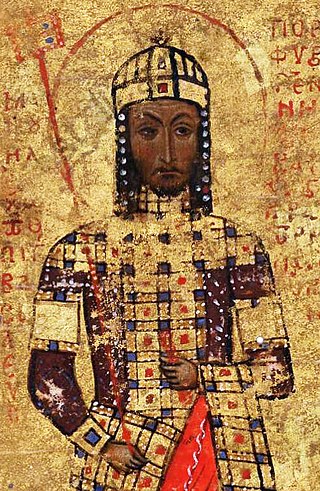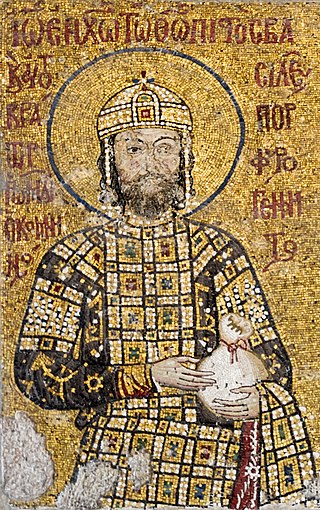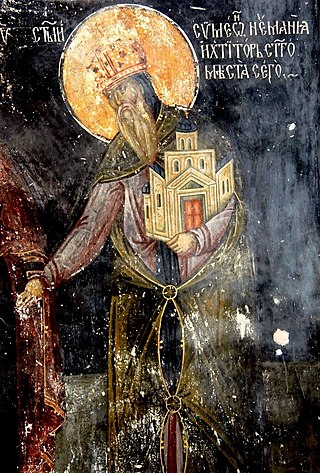
Manuel I Komnenos, Latinized Comnenus, also called Porphyrogennetos, was a Byzantine emperor of the 12th century who reigned over a crucial turning point in the history of Byzantium and the Mediterranean. His reign saw the last flowering of the Komnenian restoration, during which the Byzantine Empire had seen a resurgence of its military and economic power and had enjoyed a cultural revival.

John II Komnenos or Comnenus was Byzantine emperor from 1118 to 1143. Also known as "John the Beautiful" or "John the Good", he was the eldest son of Emperor Alexios I Komnenos and Irene Doukaina and the second emperor to rule during the Komnenian restoration of the Byzantine Empire. As he was born to a reigning emperor, he had the status of a porphyrogennetos. John was a pious and dedicated monarch who was determined to undo the damage his empire had suffered following the Battle of Manzikert, half a century earlier.

Stefan Nemanja was the Grand Prince of the Serbian Grand Principality from 1166 to 1196. A member of the Vukanović dynasty, Nemanja founded the Nemanjić dynasty, and is remembered for his contributions to Serbian culture and history, founding what would evolve into the Serbian Empire, as well as the national church. According to the Serbian Academy of Sciences and Arts, Nemanja is also among the most remarkable Serbs for his literary contributions and altruistic attributes.
The Treaty of Devol was an agreement made in 1108 between Bohemond I of Antioch and Byzantine Emperor Alexios I Komnenos, in the wake of the First Crusade. It is named after the Byzantine fortress of Devol. Although the treaty was not immediately enforced, it was intended to make the Principality of Antioch a vassal state of the Byzantine Empire.
Radoslav was the Prince of Duklja from c. 1146 to c. 1149. As the oldest son, he succeeded as ruler of Duklja after the death of his father, Gradinja in c. 1146. He was installed by Manuel I Komnenos upon a visit to Constantinople to pay homage to the Emperor. Unlike his father who was a titular king, Radoslav had the title of Prince (knez). Radoslav began his rule at a time when the Serbs of Raška had ambitions towards Duklja.
Isaac Komnenos or Comnenus, was the third son of Byzantine Emperor John II Komnenos by Irene of Hungary. He was bypassed by his father in favour of his younger brother Manuel I Komnenos for the succession, leading to a tense relationship between the two brothers after. He participated in the campaigns of his father and brother in Asia Minor, and was a fervent adherent of Patriarch Cosmas II of Constantinople, but little else is known about his life.
Desa was the Serbian co-ruler from 1148 to 1153, alongside his elder brother Uroš II, Grand Prince of Serbia; the Prince of Duklja, Travunija and Zahumlje from 1149 to 1162; the Grand Prince of Serbia from 1153 to 1155, and again from 1162 to 1166.

The Byzantine Empire was ruled by emperors of the Komnenos dynasty for a period of 104 years, from 1081 to about 1185. The Komnenian period comprises the reigns of five emperors, Alexios I, John II, Manuel I, Alexios II and Andronikos I. It was a period of sustained, though ultimately incomplete, restoration of the military, territorial, economic and political position of the Byzantine Empire.
John Axouch or Axouchos, also transliterated as Axuch was the commander-in-chief of the Byzantine army during the reign of Emperor John II Komnenos, and during the early part of the reign of his son Manuel I Komnenos. He may also have served as the de facto chief of the civil administration of the Byzantine Empire.

Wars between the Normans and the Byzantine Empire were fought from c. 1040 until 1185, when the last Norman invasion of the Byzantine Empire was defeated. At the end of the conflict, neither the Normans nor the Byzantines could boast much power, as by the mid-13th century exhaustive fighting with other powers had weakened both, leading to the Byzantines losing Asia Minor to the Ottoman Empire in the 15th century, and the Normans losing Sicily to the Hohenstaufen.
Andronikos Komnenos Kontostephanos, Latinized Andronicus Contostephanus, was a major figure in the Eastern Roman Empire during the reign of his uncle Manuel I Komnenos as a general, admiral, politician and a leading aristocrat.
Uroš II, also known as Primislav (Примислав) or Prvoslav (Првослав), was Serbian Grand Prince from c.1145 to 1162, with brief interruptions as ruler by Desa, his brother. His rule was characterized by a period of power struggle, not only of the Serbian throne between the brothers but between the Byzantine Empire and Kingdom of Hungary, of which he took advantage. He had two brothers Desa and Beloš, and a sister Helena of Serbia, Queen of Hungary. Furthermore, Uroš II also had to contend with the Second Norman invasion of the Balkans (1147-1149).
Uroš I was the Grand Prince of the Grand Principality of Serbia from about 1112 to 1145.
Anna Diogenissa was a Byzantine noblewoman of the Diogenes house who became the Grand Princess consort of Serbia as wife of Uroš I Vukanović. She had five children with Uroš I, including the successor, Uroš II.
John Roger or Rogerios, also known as John Dalassenos, was a Byzantine aristocrat of Norman descent, son-in-law of Byzantine emperor John II Komnenos and Caesar. In 1143, he unsuccessfully conspired to seize the throne.

Grand Principality of Serbia, or Rascia, was a medieval Serbian state that existed from the second half of the 11th century up until 1217, when it was transformed into the Kingdom of Serbia. Initially, the Grand Principality of Serbia emerged in the historical region of Raška, and gradually expanded, during the 12th century, encompassing various neighboring regions, including territories of modern Montenegro, Herzegovina, and southern Dalmatia. It was founded by Grand Prince Vukan, who initially served as regional governor of Raška, appointed by King Constantine Bodin. During Byzantine-Serbian wars Vukan gained prominence and became self-governing ruler in inner Serbian regions. He founded the Vukanović dynasty, that ruled the Grand Principality. Through diplomatic ties with the Kingdom of Hungary, Vukan′s successors managed to retain their self-governance, while also recognizing the supreme overlordship of the Byzantine Empire, up to 1180. Grand Prince Stefan Nemanja (1166–1196) gained full independence and united almost all Serbian lands. His son, Grand Prince Stefan was crowned King of Serbia in 1217, while his younger son Saint Sava became the first Archbishop of Serbs, in 1219.
Constantine Angelos was a Byzantine aristocrat who married into the Komnenian dynasty and served as a military commander under Manuel I Komnenos, serving in the western and northern Balkans and as an admiral against the Normans. He was the founder of the Angelos dynasty, which went on to rule the Byzantine Empire in 1185–1204 and found and rule the Despotate of Epirus (1205–1318) and the Empire of Thessalonica (1224–1242/46).
Stephen Kontostephanos was a Byzantine aristocrat and military commander.

The Battle of Brindisi (1156) was fought by the Byzantine Empire and the Norman Kingdom of Sicily over control of Southern Italy.
The Byzantine–Hungarian War was a series of border conflicts between the Byzantine Empire and the Kingdom of Hungary, took place in the Balkans in the period from 1149 to 1155. The conflict was highly affected by international disputes which arose in Europe since the 1140s, primarily between Manuel I Komnenos and Roger II of Sicily. The war broke out when Géza II of Hungary provided military assistance to the Serbs of Rascia (Raška), who rebelled against the Byzantine suzerainty. The conflict ended with peace treaty, which restored status quo ante bellum, but the relationship remained hostile between the two realms, causing further clashes throughout the 12th century.






